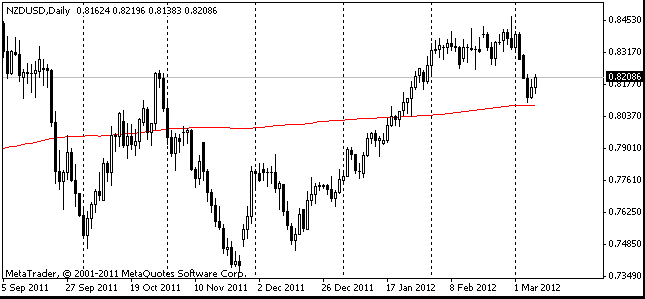EUR/usd
On Wednesday morning the markets were rather quiet, preferring to take profits after hitting fresh local highs. However, already in the afternoon the attempts to reach new highs ended with success. This night the S&P futures rose to 1403 after closing of the American session. It's not the first day we see the following picture: American investors eagerly buy risky assets, while during the Asian and European sessions there dominates a cautious or defensive trading. Such behaviour is directly connected with the general economic performance and news coming from the region. Yesterday Germany once again demonstrated a perfect level of trade balance. The surplus made 16.2bln, the figure last seen in April and before that only in December 2009. Though at that point of time the euro was 15% more expensive than now and this means that the situation with exports was much better then. Once again it proves that German affairs are far from ideal. Two days ago we learnt that factory orders are now 8% fewer than a year ago. Yesterday it became known that the industrial production shrank by 0.9% in June and by 0.3% against the level recorded in June 2011. Frankly speaking, with such a low euro rate, observed since the end of May, factory orders could have been much better. This picture once again gives evidence of the overall decline of the European economic activity, resulting from the crisis and austerity in many countries. Yesterday there was a release of statistics on the US Nonfarm Productivity. Judging by the preliminary figures, the annual rate of productivity growth made 1.6% in the second quarter. Taking into account a rather moderate employment growth over this time, we can make a conclusion that American companies hired fewer employees than they could have. As a result, Unit Labour Costs immediately grew by 1.7% against the forecasted 0.5%. Today pay attention to the US trade balance. The June lows of oil price are likely to support the reduction of the US trade deficit. But on the other hand, the increase in the household demand is, on the contrary sure, to boost it. The average market outlook suggests the level of 47.5bln against 48.7bln a month before. We believe that actual data may prove to go beyond expectations. Yesterday the euro was sinking in Forex, which isn't very surprising if we take into account the poor statistics. However, the drop from 1.24 was stopped at 1.2325 due to the high demand for risky assets during the American session.

GBP/USD
Against our expectations Mervyn King contributed to the appreciation of the sterling. His comments on the quarterly inflation report included hints that the launched funding for lending scheme would boost the reduction of interest rates for consumers and companies. If this scheme works as planned (it was launched just at the beginning of August, so there are no results yet), it will reduce the probability of further extension of bond-buying programme. Generally speaking, it is good that the BoE employs this scheme as the QE extensions haven't brought any particularly positive results yet and ‘the side effect' – lower yield of gilts – would be rather undesirable at this stage. Eventually the sterling continued moving up and again reached 1.5670. This happened despite the serious revision of GDP growth for this year.

AUD/NZD
Australia and New Zealand published their local labour market statistics on one and the same day. Quite unexpectedly, employment in New Zealand declined by 0.1% in the second quarter against the forecasted growth by 0.3%. The unemployment rate grew to 6.8% against the expected decline to 6.5%, and the participation rate dropped from 68.7% to 68.4%. Australia, on the contrary, increased jobs by 14K in July. However, the figures for the second quarter aren't the best ones, demonstrating an almost zero increase in jobs. Anyway, fresh statistics are really weighty. The unemployment in Australia decreased by 5.2% over July. AUD/NZD has been actively growing within the recent three days and crossed the level of 1.30 last night. Probably, the weakness of the Kiwi will drive the pair up to the highs of last November, above 1,32.

USD/JPY
The Japanese CB keeps sitting on its hands. The two-day meeting of the monetary policy committee hasn't brought any results: neither the asset purchase programme nor the interest rate policy haven't seen any changes. The Japanese officials prefer to shake its fist at the markets, threatening them with a reprisal, but don't do anything. Who knows, probably the markets will once again dare to test the support level of 78.0, but for now the pair is moving within the channel, growing up to 78.50 with the large potential to go to 78.70.
